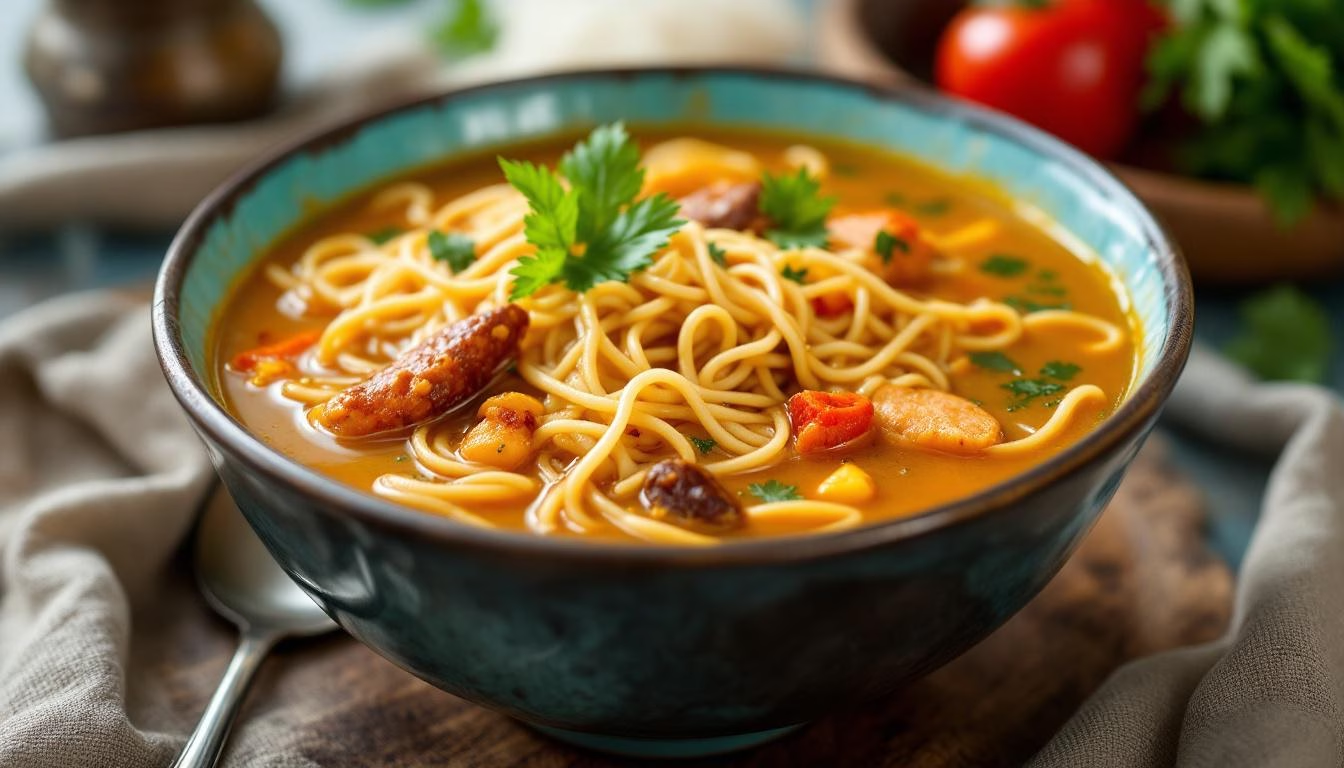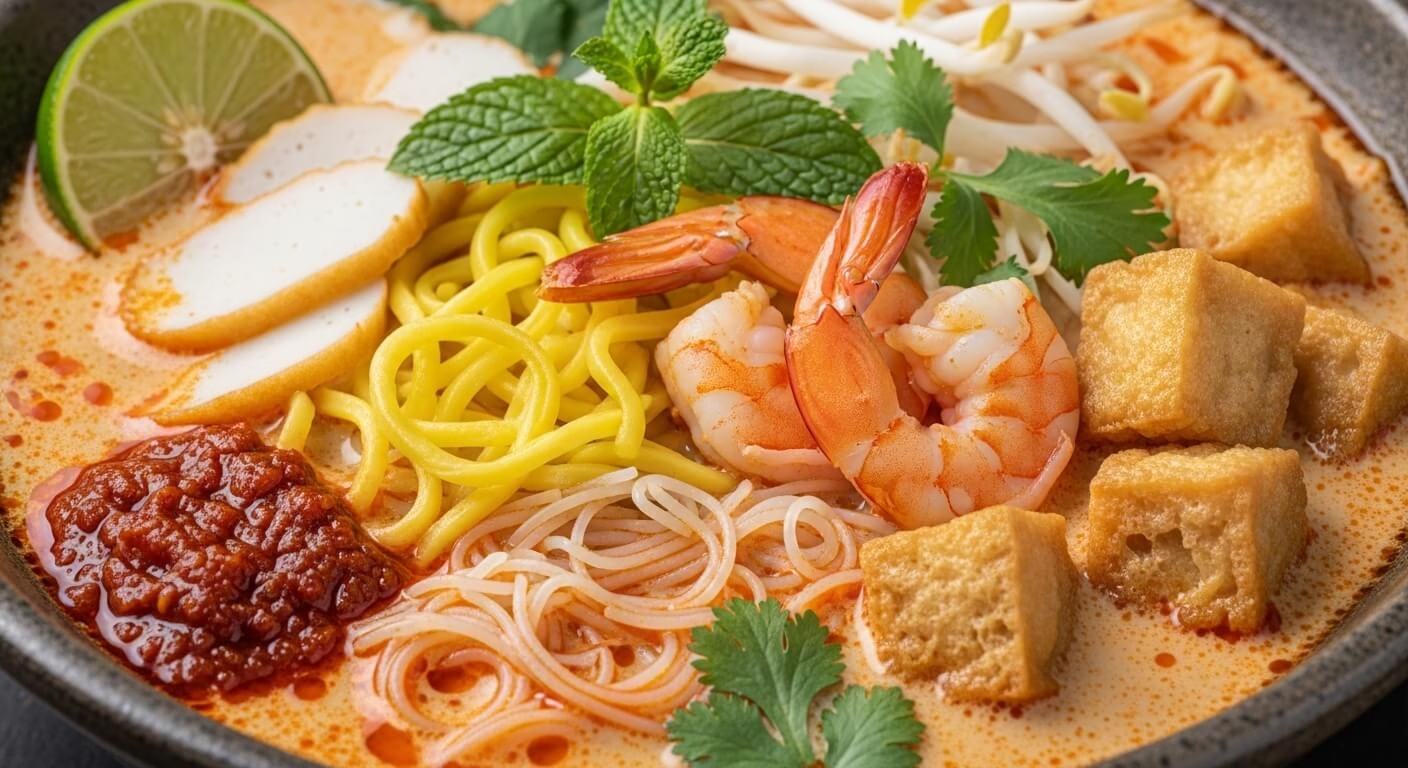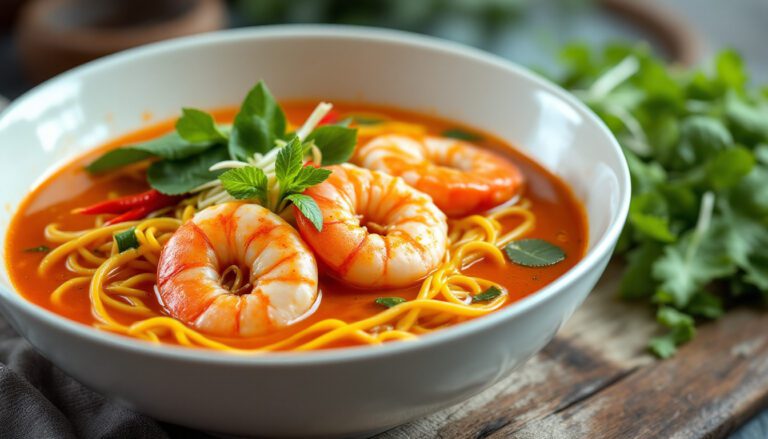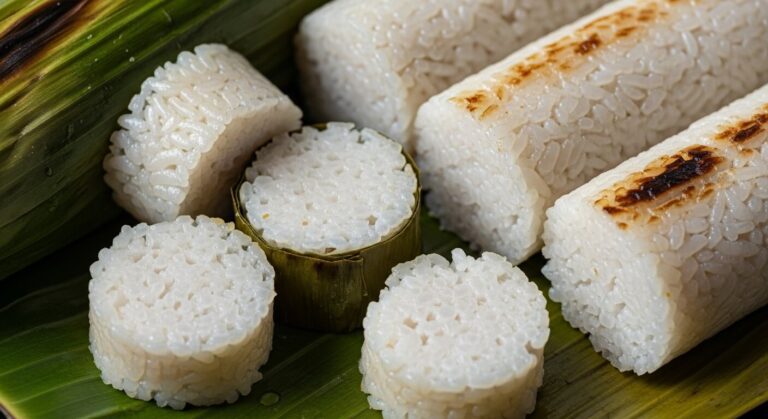Easy One-Pot Curry Laksa Recipe | Malaysian Coconut Soup
Easy One-Pot Curry Laksa (Malaysian Coconut Noodle Soup) Recipe – Let me tell you about the time I first encountered curry laksa in a tiny Malaysian street stall, where the air was thick with coconut steam and the sound of chopsticks clinking against bowls filled the cramped space.

Easy One-Pot Curry Laksa (Malaysian Coconut Noodle Soup)
Ingredients
- 1 cup canola oil (vegetable oil, or sunflower oil for frying (or cooking oil for air frying))
- 1 large Japanese eggplant (1 cm. sliced on a bias)
- 2 cups king oyster mushrooms (cut into long thin strips)
- 12 curry leaves (optional)
- 1 tablespoon canola oil (vegetable oil, or sunflower oil)
- ½ cup shallots (or red onion, diced)
- 4 teaspoons garlic (minced)
- 12 curry leaves (optional)
- 2 tablespoons sambal oelek
- 4 teaspoons red curry paste
- 1 ½ teaspoons curry powder
- 1 tablespoon palm sugar (coconut sugar, or brown sugar)
- 2 tablespoons rice vinegar (or lime juice)
- 6 cups unsalted vegetable stock (if using salted stock- hold back on the salt you add to the recipe)
- 3 servings ramen noodles (3 oz. (85 g.) each, or other noodles of your choice)
- 400 ml coconut milk
- 1 teaspoon salt (or to taste)
- 1 cup bean sprouts
- ¼ cup cilantro leaves
- 2 bird’s eye chilies (thinly sliced)
- 3 lime wedges
- 12 tofu puffs (cut in halves (or use homemade fried tofu instead))
Instructions
- Heat the oil in a large pot over medium-high. When hot, add the curry leaves and fry for 45–60 seconds until crisp. Lift out with a slotted spoon and set aside. For an air-fryer option, toss the curry leaves with a little oil and cook at 350°F (175°C) for 3–4 minutes; set aside.
- With the curry leaves removed, add the sliced eggplant to the oil and fry for 4–5 minutes until golden brown. Lift out with a slotted spoon and drain on a wire rack set over a baking pan. For air frying, lightly spray the slices with cooking oil and cook at 400°F (200°C) for 6–7 minutes until golden and tender.
- After removing the eggplant, fry the king oyster mushrooms until browned and crispy, then transfer to the wire rack to cool and drain. Carefully discard the oil from the pot so it’s clean for the next steps. Or, lightly coat the mushrooms with cooking spray and air fry at 400°F (200°C) for 5–6 minutes, just until tender.
- Add 1 tablespoon oil to the pot over medium heat. After about 90 seconds, when hot, sauté the diced shallots for 4 minutes until translucent and fragrant.
- Stir in the minced garlic, curry leaves, sambal oelek, red curry paste, and curry powder. Cook for a couple of minutes until fragrant.
- Add the rice vinegar, pour in the vegetable stock, and increase the heat to high to bring the broth to a boil.
- When boiling, add the noodles and cook until al dente, following the package directions.
- Turn off the heat, stir in the coconut milk, and add salt to taste.
- To assemble, use tongs to evenly distribute the noodles in the center of each bowl. Ladle the curry broth over the noodles. Top with the fried eggplant, mushrooms, and curry leaves. Garnish with bean sprouts, cilantro leaves, bird’s eye chilies, lime wedges, and tofu puffs, using a spoon to briefly submerge the tofu puffs in the broth so they absorb some flavor.
Nutrition
I was twenty-three, hopelessly jet-lagged, and convinced I’d made a terrible mistake ordering something I couldn’t pronounce from a menu I couldn’t read.
The vendor, a woman who couldn’t have been taller than my shoulder, ladled what looked like liquid sunshine into a bowl, topped it with an avalanche of bean sprouts and herbs, and slid it across the metal counter with a knowing smile.
That first spoonful was a revelation — creamy coconut milk swirled with curry spices, tender noodles that had absorbed all those gorgeous flavors, and vegetables that somehow managed to be both comforting and exotic at the same time.
I sat there, sweating in the humid air, slurping noodles like my life depended on it, and thinking: “I need to learn how to make this.” Of course, it took me about fifteen years and countless failed attempts to actually figure it out, because apparently I’m the kind of person who thinks she can recreate complex Southeast Asian flavors by throwing random curry powder into coconut milk and hoping for the best.
The thing about curry laksa is that it sounds intimidating — all those unfamiliar ingredients, the careful balance of spice and richness, the seemingly endless list of toppings.
But here’s what I’ve learned after years of kitchen disasters and small victories: this Easy One-Pot Curry Laksa (Malaysian Coconut Noodle Soup) recipe is actually incredibly forgiving, and once you understand the basic technique, you’ll be making bowls that rival those street stalls.
Malaysian Curry Laksa Recipe: Simple One-Pot Coconut Noodle Recipe
Curry laksa isn’t just soup — it’s a cultural love letter written in coconut milk and spice.
This Malaysian comfort food represents the beautiful fusion that happens when Chinese noodle traditions meet Malay curry techniques, creating something entirely new and utterly delicious.
Traditional laksa varies dramatically across Malaysia and Singapore, with each region claiming their version is the “real” one, but curry laksa specifically refers to the coconut milk-based variety that’s rich, aromatic, and deeply satisfying.
The beauty of this Easy One-Pot Curry Laksa (Malaysian Coconut Noodle Soup) recipe lies in its accessibility — we’re using ingredients you can find in most well-stocked grocery stores, while still honoring the essential flavors that make laksa so special.
The key players here are coconut milk for richness, curry paste and powder for depth, and a careful balance of sweet, salty, and tangy elements that create that characteristic laksa flavor profile.
What makes this version particularly brilliant is the one-pot approach.
Instead of juggling multiple pans and complicated timing, everything comes together in a single pot, building layers of flavor as you go.
We start by crisping curry leaves and frying our vegetables to develop deep, caramelized flavors, then build the aromatic base with shallots, garlic, and spices before adding the liquid components.
Ingredients That Make the Magic Happen
Before we dive into cooking, let’s talk about the stars of this Easy One-Pot Curry Laksa (Malaysian Coconut Noodle Soup) recipe.
Each ingredient serves a specific purpose, and understanding why they’re there will help you make substitutions if needed.
The Aromatics and Spice Base
Shallots form the foundation of our flavor base — they’re sweeter and more delicate than regular onions, which is exactly what we want here.
If you can’t find shallots, red onion works beautifully as a substitute.
The garlic should be minced fine so it doesn’t overpower the other flavors, and fresh curry leaves add an irreplaceable citrusy, almost nutty aroma that dried leaves simply can’t match.
Sambal oelek and red curry paste are our spice workhorses.
Sambal oelek brings pure chili heat without overwhelming other flavors, while red curry paste contributes complex layers of lemongrass, galangal, and other aromatics.
The curry powder ties everything together with warm, earthy notes that scream “comfort food.”
The Vegetables and Protein
Japanese eggplant is perfect here because it fries up beautifully without becoming mushy, and its mild flavor absorbs all those gorgeous curry notes.
King oyster mushrooms provide meaty texture and umami depth — when fried, they develop crispy edges that add textural contrast to the silky broth.
Tofu puffs are little sponges of joy that soak up the curry broth like tiny flavor bombs.
If you can’t find them, you can make your own by deep-frying cubed firm tofu until golden and puffy, or simply use regular firm tofu cut into cubes.
Step-by-Step: Building Your Curry Laksa
The secret to exceptional curry laksa lies in building layers of flavor, and this Easy One-Pot Curry Laksa (Malaysian Coconut Noodle Soup) recipe walks you through each step methodically.
Preparing the Crispy Elements
Start by heating your oil in a large, heavy-bottomed pot — cast iron or enameled Dutch ovens work beautifully here.
When the oil shimmers (around 350°F if you’re using a thermometer), add the curry leaves first.
They’ll sizzle dramatically and become crispy in about 45-60 seconds.
This step isn’t just about the leaves themselves; it’s about infusing the oil with their unique flavor.
Next comes the eggplant, sliced on the bias for maximum surface area.
Fry these beauties until they’re golden brown and tender, about 4-5 minutes.
Don’t overcrowd the pot — work in batches if needed.
The key is achieving that perfect balance where the exterior is caramelized but the interior remains creamy.
The king oyster mushrooms go in last, and they’ll brown quickly due to their low moisture content.
You want them crispy on the outside but still tender within.
Once everything is fried and drained, carefully discard the oil — we’re done with the deep-frying portion of our program.
Building the Aromatic Base
With a clean pot and just a tablespoon of fresh oil, we begin building our curry base.
Sauté the shallots over medium heat until they’re translucent and fragrant — this usually takes about 4 minutes.
Don’t rush this step; properly cooked shallots provide sweetness that balances the heat and spice coming later.
Add the garlic, curry leaves, sambal oelek, red curry paste, and curry powder all at once.
This might seem overwhelming, but cooking them together for a couple of minutes allows the flavors to bloom and meld.
Your kitchen should smell absolutely incredible at this point — if it doesn’t, you’re probably not cooking the spices long enough.
Creating the Broth
The rice vinegar goes in next, providing acidity that brightens all those rich, warm flavors.
Then comes the vegetable stock — pour it in confidently and crank the heat to high.
We want a rolling boil to properly cook our noodles and meld all the flavors.
When the stock reaches a boil, add your noodles.
Ramen noodles work perfectly here, but you can substitute rice noodles, udon, or even spaghetti in a pinch.
Cook them until just al dente — they’ll continue cooking slightly in the hot broth even after you turn off the heat.
The Final Touch
Here’s where the magic happens: turn off the heat completely before stirring in the coconut milk.
This prevents the coconut milk from breaking or curdling, which can happen if it gets too hot too quickly.
Stir gently but thoroughly, and taste for salt.
Remember, you can always add more, but you can’t take it back.
Pro Tips for Curry Laksa Success
After making this Easy One-Pot Curry Laksa (Malaysian Coconut Noodle Soup) recipe more times than I care to admit, I’ve learned a few tricks that make the difference between good laksa and great laksa.
Temperature Control Is Everything
The biggest mistake I see people make is adding coconut milk to boiling broth.
Coconut milk is temperamental — it wants to be treated gently.
Always remove your pot from heat before stirring it in, and if you’re reheating leftovers, do so over low heat while stirring frequently.
Prep Your Garnishes in Advance
Laksa is all about the toppings, and having everything ready before you start cooking makes assembly much smoother.
Wash and drain your bean sprouts, pick your cilantro leaves, slice your chilies, and cut your lime wedges.
Trust me, you don’t want to be frantically chopping herbs while your noodles are getting mushy in the pot.
Don’t Skip the Frying Step
I know it seems like extra work, but frying the eggplant and mushrooms separately creates textural contrast that makes this dish special.
If you’re really opposed to deep frying, the air fryer method works well, but don’t just throw raw vegetables into the broth and hope for the best.
Adjust Heat to Your Preference
The beauty of making this at home is controlling the spice level.
Start with the amounts listed, then taste and adjust.
You can always add more sambal oelek or fresh chilies, but you can’t dial back the heat once it’s in there.
Storage and Reheating
This soup keeps well in the refrigerator for up to three days, but store the noodles separately if possible — they tend to absorb liquid and become mushy.
When reheating, add a splash of coconut milk or stock to restore the proper consistency.
Variations to Make It Your Own
Once you’ve mastered the basic Easy One-Pot Curry Laksa (Malaysian Coconut Noodle Soup) recipe, there are endless ways to customize it to your taste or dietary needs.
Protein Variations
While this version is beautifully vegan, you can easily add protein.
Shrimp work wonderfully — add them during the last few minutes of cooking so they don’t become rubbery.
Chicken thighs, cut into bite-sized pieces, can be added with the stock and simmered until cooked through.
For a vegetarian option with more protein, try adding cubed firm tofu or tempeh.
Vegetable Swaps
Can’t find Japanese eggplant?
Regular eggplant works, though you might want to salt it first to remove bitterness.
Zucchini, bell peppers, or even sweet potato make excellent substitutions.
The key is choosing vegetables that hold their shape when cooked and complement the curry flavors.
Noodle Options
Ramen noodles are traditional and work beautifully, but don’t be afraid to experiment.
Rice vermicelli creates a more delicate texture, while udon noodles make the dish heartier.
Even whole wheat spaghetti works in a pinch — just adjust cooking times accordingly.
Heat Level Adjustments
For a milder version, reduce the sambal oelek and omit the bird’s eye chilies from the garnish.
For heat lovers, add a sliced jalapeño to the aromatic base or include some fresh Thai chilies.
Remember, you can always serve extra chilies on the side for people to add their own heat.
What to Expect: The Reality of Homemade Laksa
Let’s be honest about what you’re getting into with this Easy One-Pot Curry Laksa (Malaysian Coconut Noodle Soup) recipe.
This isn’t a throw-everything-in-a-pot-and-walk-away kind of meal.
It requires about 30 minutes of active cooking time, and yes, you’ll dirty a few dishes along the way.
But here’s what you get in return: a deeply satisfying, restaurant-quality soup that costs a fraction of what you’d pay for takeout and tastes infinitely better than anything from a packet.
Your first attempt might not be perfect — mine certainly wasn’t.
Maybe your eggplant will be a little too soft, or your broth might need more salt.
That’s completely normal and part of the learning process.
Each time you make it, you’ll understand the flavors better and develop your own preferences for spice level and consistency.
The real magic happens when you serve this to people.
There’s something about a steaming bowl of curry laksa that makes people stop talking and just focus on eating.
The combination of creamy coconut broth, tender noodles, and all those beautiful toppings creates a sensory experience that’s both comforting and exciting.
Don’t be surprised if this becomes your go-to recipe for impressing dinner guests or treating yourself to something special on a weeknight.
It’s the kind of dish that makes your kitchen smell like a Southeast Asian paradise and reminds you why cooking from scratch is always worth the effort.
Plus, you’ll have leftovers that taste even better the next day — if there are any leftovers, that is.








